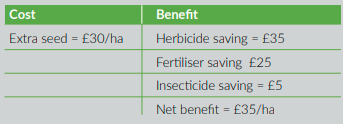Farm Manager at Overbury Farms

The Farm
Overbury Farms is an integrated part of Overbury Enterprises which has been in the same family for over 250 years. It is a mixed farm that produces a range of crops including wheat, barley, oilseed rape (OSR), pease, linseed and soya beans. We also let out certain areas of our farm to specialist growers who produce crops such as onions and peas. The farm also has a flock of 1,200 sheep and home-bred Texel Cross Mules. The ewes are a mixture of Mules, Aberfields and Lleyn crossed Romneys. All lamb is LEAF marque certified which is an environmental assurance system that recognises sustainably farmed produce. Produce and livestock are sold to high street supermarkets as well as local markets and food outlets. OSR is sold on to Unilever and our barley is harvested and sold to Molson Coors.
Watch a video by scanning the QR Code opposite (recorded at an intercropping event) of Jake introducing the farm and talking about the importance of no till and cover cropping.

Sustainability In Practice:
Building soil fertility and reducing weeds through carefully planned rotations, no till, intercropping and cover crops The 6 year rotation at Overbury includes winter and spring barley, OSR, winter wheat, peas, linseed and soya beans. We have reintegrated livestock and now graze ley mixtures with home bred Texel, Abermax and SufTex lambs. This has the benefit of breaking weed lifecycles and also allowing the restorative periods in the rotation.
The system has been no till since 2013 (on some trial blocks, most of the farm came in from July 2015), which has had a very noticeable impact on soil quality, infiltration and biology – evidenced by some giant worms that we have found here lately! On most occasions we leave some straw and use mollasses and humates to help break it down. I don’t use seed treatments as the effect on mychorrhizzae is compromising the essential life in the soil, and instead have farm-saved untreated seed (seed is tested for fusarium mainly and if clean enough it’s not dressed).
If the soil is going to be uncovered for more than 5 weeks, I will put in a cover crop. In monoculture there is no room for genetic variation. A field of wheat is full of genetically identical plants and everything is vulnerable to the same pests and diseases. In a crop mixture you can guarantee that something will grow regardless of what conditions come your way. But it is not so much what happens above ground as below. Speaking to fellow Nuffield Scholar Andy Howard, I was inspired to give companion cropping a try…
Our most common species mixture (or ‘plant team’) is OSR, vetch and buckwheat. We have 4 hoppers on the Cross Slot drill (one also for slug pellets) and drill it at the same depth in the autumn – seed rates of approx. 7kg buckwheat, 2.5kg OSR and 13.5kg vetch per hectare (ha). As we found we were attracting a lot of pheasants in the crop, we are now using a mixture of 2.5kg/ha OSR, 2kg/ha burseem clover and 10kg/ ha vetch. Each species has different functions in the mixture. The vetch is deep rooting and breaks compaction to open up the soil for the OSR and also provides residual nitrogen; the buckwheat is good for creating a cover to smother weeds, making phosphate more available and distracting pests as well as providing a structural function to stop the crop going flat.
In these mixtures we use no pre-emergence herbicide as we rely on the competition effect to smother broadleaf weeds. Astrocurb is the only broadleaf herbicide we use to kill off the buckwheat and vetch and stop them growing over. Frost will take out buckwheat at less than 5˚C. A simple cost benefit analysis shows that despite the higher costs of seed, we are saving approximately £35/ha on inputs with the intercrop versus a monocrop of OSR.

We also undersow a mixture of red clover, perennial ryegrass (PRG), plantain and chicory into spring barley. This year we had a yield of 6 tonnes / ha with no herbicide. I deliberately chose those fields that have a brome problem to help get on top of it. This then goes into a 2 year ley for sheep. Another mixture we are trying is kale undersown with white clover for fattening lambs. Once grazed we then direct drill winter wheat into the white clover. I am interested to continue experimenting with this – an understory of white clover for the whole rotation would be good. One example of this experimentation was a recent cover crop of rye, vetch, phacelia, and buckwheat drilled into soya ahead of soya beans which were planted the following spring. The cover crop provided a valuable habitat for pollinators in November when there is not much else available.
I am pleased to say that blackgrass is now a diminishing issue – it’s now just a spot of leisurely hand rouging on a Sunday afternoon! I think this is a combination of 5 years no till, spring cropping and having a cover at all times (if the soil is going to be bare for more than 5 weeks I put a cover in). We also try to drill later but I am cautious not to push it back too far in a no till system – although the soils are drier. There are barriers to farming in this way – there are some machinery requirements; we need to consider the rotation effects and limit the ‘green bridges.’ Finding markets for crops such as buckwheat is also a challenge, as is important to get spring crops to contribute enough to gross margins… But I think the biggest barriers are in our minds! Have to stop worrying what the neighbours will think and take the plunge and try something new…
Motivations:
Overbury Farms became a member of LEAF in 2003 due our core belief that intensive farming also needs to be environmentally sustainable. We then gained LEAF Marque status in 2007 and we proudly became a LEAF Demonstration Farm in 2012. This allows us to promote Integrated Farm Management (IFM) and show our strategies to achieve sustainable farming with the agricultural supply chain as well as the local community through farm visits. LEAF membership has helped us implement many strategies in order to enhance yields while being conscious of the environment.
In 2013 I was awarded a Nuffield Farming Scholarship to study the possibilities of growing 20 t/ha of wheat in a sustainable farming system while following IFM – ‘Breaking the Wheat Yield Plateau in the UK.’ Through this project I visited several countries including Canada, Mexico and the United States to understand the limiting factors of high yielding wheat crops and what the main mitigation strategies were that were in place. Differing climates produces a range of challenges when faced with growing high yielding wheat crops and this project allowed me to witness these problems first hand and to bring solutions back to the UK with the potential to use them on British wheat crops. One of the big eye openers for me was to realise that we are in fact abusing the soil by overcultivation. I came to the conclusion that we need more diversity to enable us to overcome some of these challenges. Increased soil management, more diverse rotations and livestock integration are all key to increasing wheat yields.
Farmer Tips
• Always keep soil covered.
• Consider what your objectives are with mixtures before selecting them i.e. weed suppression, increasing protein, combating pests and diseases…?
• The biggest barrier is in your mind!
Farm Facts
FARM SIZE: 1,538 hectares
MANPOWER: 6 full time staff
FARM TYPE: Mixed
NUMBER OF LIVESTOCK: 1,200 sheep
TENURE: Owner occupied
REGION: South West England
RAINFALL: 843 mm
ALTITUDE: 229 m – Bredon Hill Summit
SOIL: Brash
APPROACH: Integrated Farming
KEY FARMING PRACTICES: No Till Trap crops Mixed farming Companion crops Cover crops Diversified rotation Intercropping
